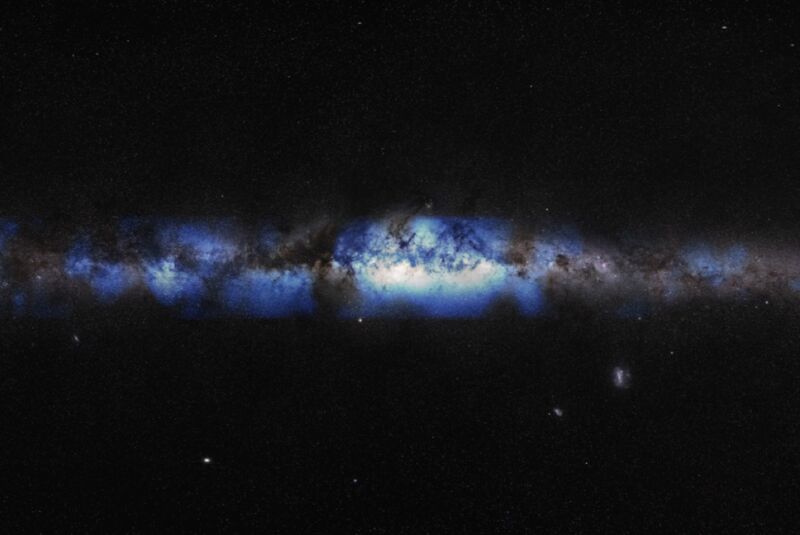

This is what our Milky Way galaxy looks like when viewed with neutrinos
source link: https://arstechnica.com/science/2023/06/ghost-particles-have-given-us-a-striking-new-view-of-our-milky-way-galaxy/
Go to the source link to view the article. You can view the picture content, updated content and better typesetting reading experience. If the link is broken, please click the button below to view the snapshot at that time.

Through a neutrino lens —
This is what our Milky Way galaxy looks like when viewed with neutrinos
We now have strong evidence that the Milky Way is a source of high-energy neutrinos.
Jennifer Ouellette - 6/29/2023, 6:32 PM

Scientists with the IceCube Neutrino Observatory have unveiled a striking new image of our Milky Way galaxy as seen by ghost-like messenger particles called neutrinos. This new analysis—announced at a Drexel University event today, with a paper being published in the journal Science tomorrow—offers the strongest evidence to date that the Milky Way is a source of high-energy neutrinos, shedding more light on the origin of high-energy cosmic rays.
"I remember saying, 'At this point in human history, we're the first ones to see our galaxy in anything other than light,'" said Drexel University physicist and IceCube member Naoko Kurahashi Neilson of the moment she and two graduate students first examined the image. “Observing our own galaxy for the first time using particles instead of light is a huge step. As neutrino astronomy evolves, we will get a new lens with which to observe the universe.”
As previously reported, ever since French physicist Pierre Auger proposed in 1939 that cosmic rays must carry incredible amounts of energy, scientists have puzzled over what produces these powerful clusters of protons and neutrons raining down into Earth's atmosphere. One way to identify the sources is to backtrack the paths that high-energy cosmic neutrinos traveled on their way to Earth since they are created by cosmic rays colliding with matter or radiation, producing particles that then decay into neutrinos and gamma rays.
Most neutrino hunters bury their experiments deep underground, the better to cancel out noisy interference from other sources. In the case of IceCube, the collaboration features arrays of basketball-size optical sensors buried deep within the Antarctic ice. On those rare occasions when a passing neutrino interacts with the nucleus of an atom in the ice, the collision produces charged particles that emit UV and blue photons. Those are picked up by the sensors. So IceCube is well-positioned to help scientists advance their knowledge of the origin of high-energy cosmic rays.
AdvertisementOne strong possible source for high-energy cosmic rays is active galactic nuclei (AGNs), found at the center of some galaxies. Their energy arises from supermassive black holes at the galaxy's center and/or from the black hole's spin. It's not an easy task to locate high-energy neutrino sources in space, given the large number of background neutrinos and other particles in the Earth's atmosphere. IceCube records roughly 100 million muons for every single neutrino it detects, for instance. In 2018, IceCube picked up a flare of neutrinos that seemed to be coming from a type of AGN called a blazar. But they needed to find other similar cosmic neutrino sources to reconcile that observation with existing neutrino models.
In 2020, the IceCube collaboration analyzed data collected between 2008 and 2018. They found a tantalizing hint of 63 excess neutrinos coming from the direction of four AGN, although only one—Messier 77 (aka NGC 1068, or the Squid Galaxy)—reached any statistical significance. Even so, it was just 2.9 sigma, short of what's required to claim discovery; it could have simply been a random background fluctuation.
So the IceCube scientists revisited the data again last year, this time incorporating machine-learning techniques to better reconstruct the trajectories and energies of the photons picked up by the detectors. Then they reprocessed that same 10 years of data. The result: an excess of 79 neutrinos over the background, with a statistical significance of 4.2 sigma. So Messier 77 is indeed a strong candidate for one such high-energy neutrino emitter.
Page:
Recommend
About Joyk
Aggregate valuable and interesting links.
Joyk means Joy of geeK
